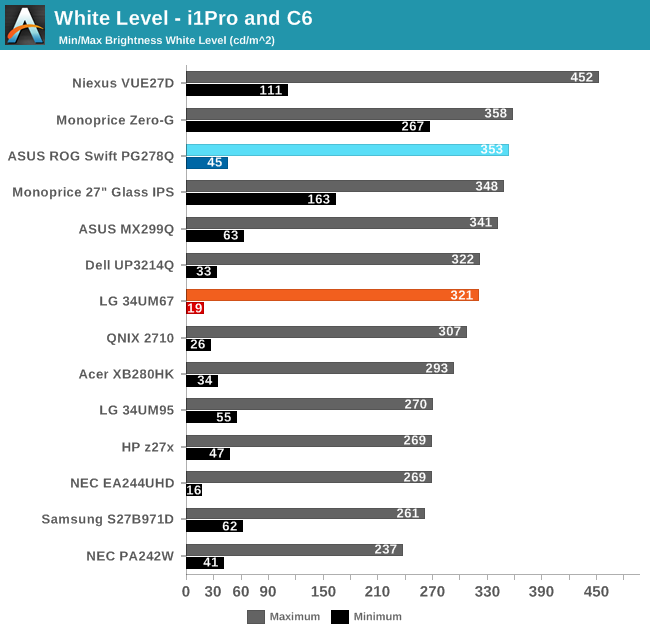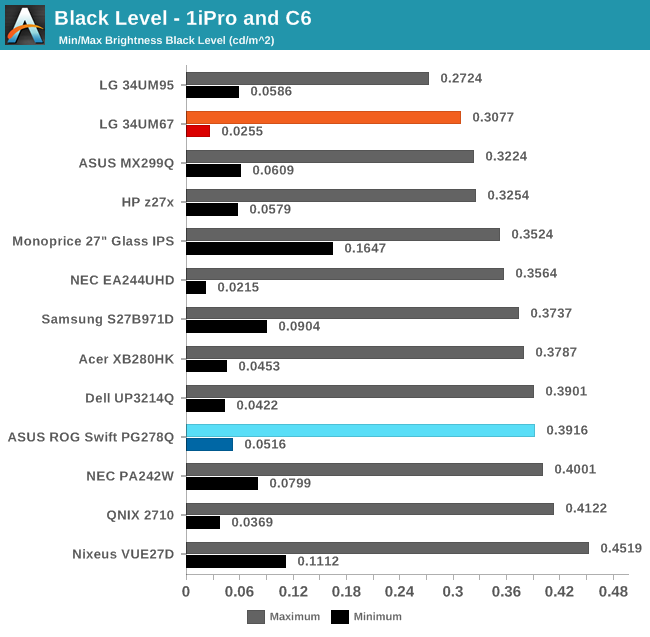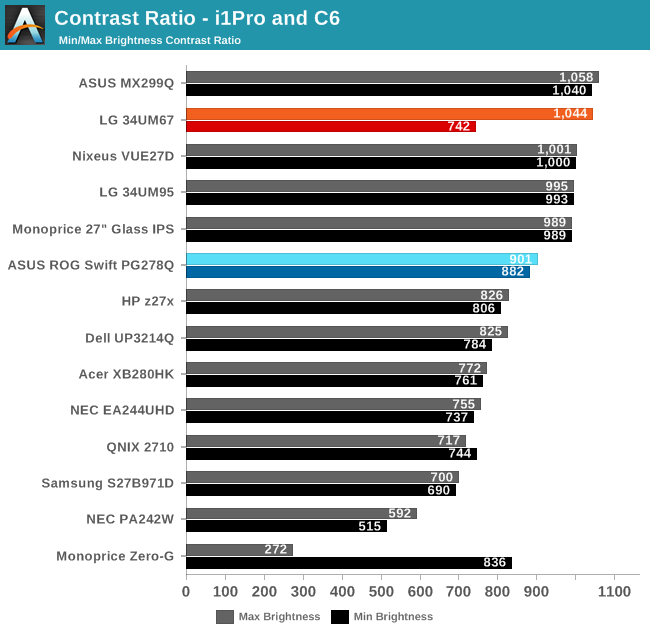LG 34UM67: UltraWide FreeSync Review
by Jarred Walton on March 31, 2015 3:00 PM ESTLG 34UM67 Brightness and Contrast
Moving on from the FreeSync discussion, we still need to see how the LG 34UM67 fares as a display. We’ve run our usual assessments to look at brightness, contrast, color accuracy, and uniformity. We’ll start with the brightness results. The LG FreeSync 34UM67 is in orange/red while we've highlighted the ASUS PG278Q in cyan/blue.

Set to maximum brightness with the default (50/50/50) RGB values, the 34UM67 can output 306 nits, which is just above the rated 300 nits. However, you can increase the output a bit more by maxing out the RGB values at 100, which gives us the above result of 321 cd/m2. This is plenty bright for most people, and more than I would normally need (outside of situations where the display needs to overcome reflections and lights during the day.) Setting the brightness to the minimum level with 50% RGB drops the display to 52 cd/m2, which is perhaps a bit too bright, but if you tweak RGB settings you can get as low as 19 cd/m2. That can work even in very dark rooms, so LG has covered all the necessary output range.

Black levels are okay but nothing amazing. At the maximum backlight (with the OSD Black Stabilizer set to 0 – increasing it will increase black levels somewhat, ostensibly to help you see dark areas in games better), we measured 0.3077 cd/m2. Going to the minimum backlight level this falls down to 0.0255 cd/m2. Interestingly, LG doesn’t appear to be using any form of dynamic contrast, so whether we test with a full screen color or 50% APL patterns makes no difference. That’s a good thing if you’re wondering, as dynamic contrast often ends up being more of a distraction than a benefit (IMO).

The resulting contrast ratios range from just over 1000:1 to closer to 750:1, but the contrast ratio stays pretty consistent until the very lowest brightness settings. Also note that our i1 Pro meter isn’t the most accurate sensor for black levels, so that might contribute to some of the difference. Overall, the contrast ratio is good but not exceptional.










96 Comments
View All Comments
FXi - Monday, May 25, 2015 - link
It would have been helpful to list in the article what the "consistent" constrast ratio was. I'd be guessing it was more likt 750/800:1 given IPS performance in the past but while low and high are very useful, knowing where someone will likely land being somewhere in the middle of the road would be useful to readers. Only making a suggestion. I am always grateful for the things you DO include in your reviews and I read them pretty through and through.KarenS - Friday, July 24, 2015 - link
There are no VESA mounting holes on this monitor. Could you verify that you reviewed the correct one? I bought a "34UM67" and did not find any VESA mounting holes. The pictures on your site shows no mounting holes either.Jiffybag - Sunday, October 11, 2015 - link
How did he flatten the game curve when the monitor has no gamma controls? I bought this monitor and my gamma looks exactly like his pre calibration gamma image (starting high ending low) but as thre is NO way to calibrate gamma (only colour / white balance) I was unable to correct it? Anyone care to explain? Jarred?Jiffybag - Sunday, October 11, 2015 - link
Game = gamma (auto correct got me) :)My settings:
Backlight set to 20 (120cd/m2)
Black adjuster set to 0
Using i1Display Pro
Power savings etc all turned off
Colour calibration is good (all under delta 1.6)
Colour temp is spot on 6500k
Grey scale delta error all less than 1
Gamma set to "1" in menu
Gamma average is 2.2 BUT it's a diagonal line \ starting high (at 2.4) and ending at 1.9.
As there is no 10point gamma control I am unable to figure out how to flatten the gamma as there is no gamma controls? My HDTV has 10pt gamma control so I can raise 10/20/30 and lower 70/80/90 to flatten a curve, but this monitor has absolutely NO (ZERO) gamma controls so how on earth can he flatten it to such a decent flat line? I'm baffled? Unless he used the dynamic contrast adjuster (black level adjuster) and/or used his GFX card to make adjustments to his output, I'm unsure how he was able to do this. I'd love to know though if anyone can enlighten me :)
Jiffybag - Sunday, October 11, 2015 - link
I have a 34UM67 and it has VESA mounting holes, but no gamma correction control? :-/rya - Monday, October 19, 2015 - link
has anyone tried overclocking this monitor or altering the freesync range? I'd love to run freesync from 9hz - 80hz (or higher) if possible.